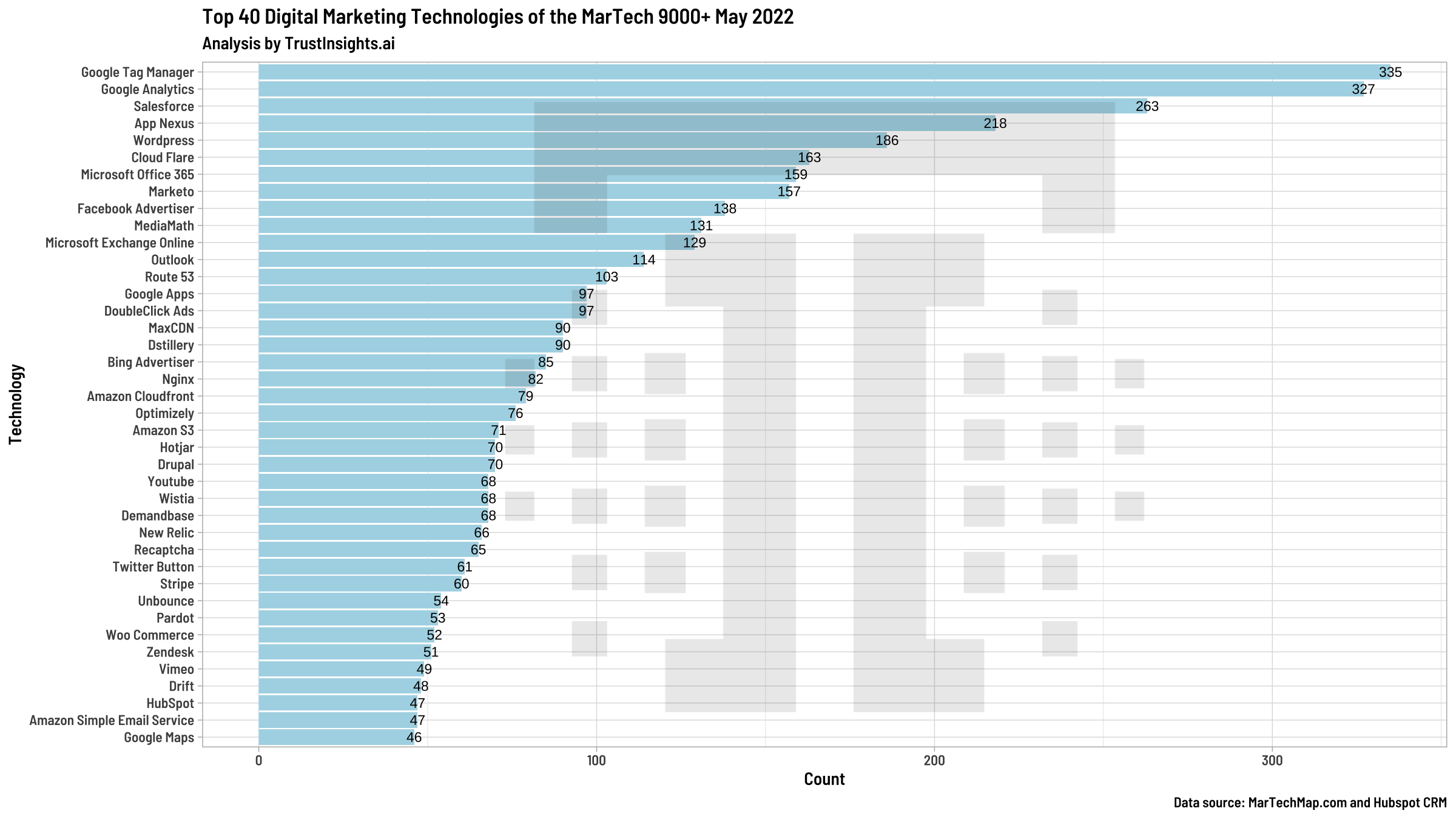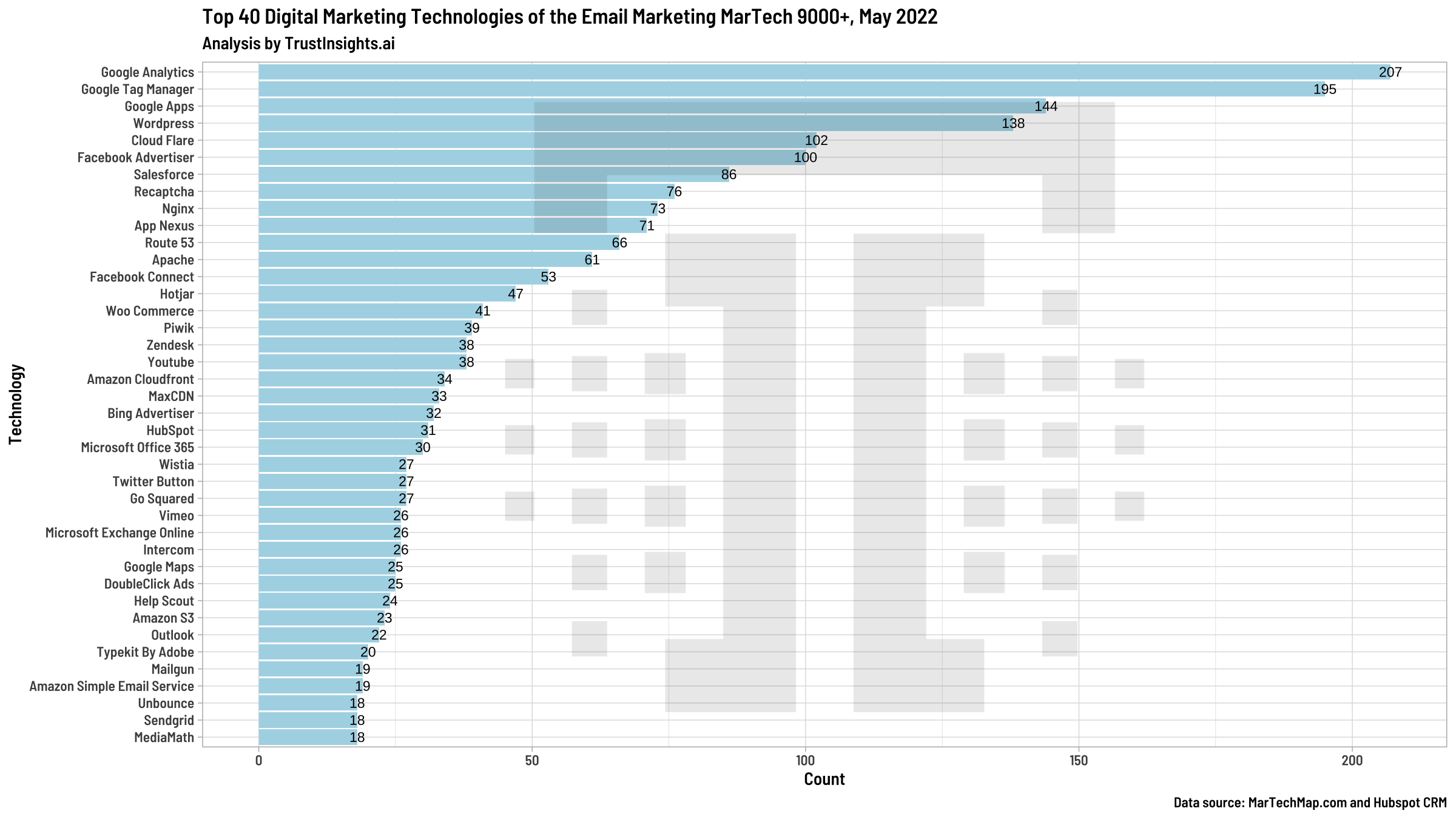One of the data collections we look forward to most eagerly every year is Scott Brinker’s MarTech landscape. This compilation of marketing technology is a who’s who of MarTech; nearly every company from the tiniest startup to global Fortune 10 companies is listed.
Every year, we wonder about the companies themselves. These are tech startups for the most part. What marketing technology do they use? What do the fastest growing companies use to push their own marketing forward?
We reached out to Scott and the team to obtain this year’s MarTech 9000, a list of more than 9,000 MarTech companies. Using this list, our own code, and third-party data appending services such as BuiltWith and Hubspot, we were able to scan all 9,000+ companies to see what the most popular marketing technologies are.
Why do this? Why should you care about what marketing technology other companies use? One of the biggest reasons is talent; when it comes to hiring people, the more widespread a technology is, the easier it is to find candidates.
A second major reason is that widespread use of a technology is a proxy for value. Generally speaking, you don’t use tools that are ineffective and don’t deliver any value. If we see a substantial number of similar companies using a specific tool, we might want to question if our own MarTech strategy has a gap in it.
Characteristics of the MarTech 9000 Companies
So, let’s first understand who is in the MarTech 9000. When we look at all the different company types, we see:
 Sales enablement tech companies top the list with more than 500 of them, followed by eCommerce platforms, then social media marketing and content marketing.
Sales enablement tech companies top the list with more than 500 of them, followed by eCommerce platforms, then social media marketing and content marketing.What are the broad characteristics of these companies? In terms of company size, here’s what we see:
 A good chunk of the MarTech 9000 is 10 employees or fewer; only 137 have 10,000 employees or more.
A good chunk of the MarTech 9000 is 10 employees or fewer; only 137 have 10,000 employees or more.Now that we have a feel for the kinds of companies in the MarTech 9000, let’s turn our eyes toward what technology they use.
Marketing Technology of the MarTech 9000
When we look at the marketing technologies used by these companies, we see some clear trends:
 The Google Marketing Platform, particularly Google Analytics and Google Tag Manager, are by far the most commonly used MarTech technologies by the companies of the MarTech 9000; 88% of the companies use some form of Google Analytics.
The Google Marketing Platform, particularly Google Analytics and Google Tag Manager, are by far the most commonly used MarTech technologies by the companies of the MarTech 9000; 88% of the companies use some form of Google Analytics.Below Google Analytics and Tag Manager, we have the WordPress CMS, Salesforce.com, Facebook Ads, and Cloudflare.
This is a good look at the overall MarTech 9000, but it begs the question of whether the technologies change once we drill down into the different kinds of companies. Let’s divide up and look at the MarTech 9000 data, filtered to companies with 5,000 employees or more.
First, the categories certainly change:
 Business intelligence/data science companies top the list, followed by CX and data enhancement.
Business intelligence/data science companies top the list, followed by CX and data enhancement.Next, what are the top marketing technologies of these large enterprises?
 Many of the technologies stay the same, even at the largest companies, except for App Nexus displacing Google Apps. App Nexus is an enterprise advertising solution, so it’s no surprise to see it among the top companies. What’s interesting is that Tag Manager nudges out Google Analytics at the largest companies, an interesting phenomenon.
Many of the technologies stay the same, even at the largest companies, except for App Nexus displacing Google Apps. App Nexus is an enterprise advertising solution, so it’s no surprise to see it among the top companies. What’s interesting is that Tag Manager nudges out Google Analytics at the largest companies, an interesting phenomenon.What does this tell us about the most popular marketing technologies? Big or small, Google Analytics is by far the most dominant marketing technology in the MarTech landscape. If you’re looking to hire people for web analytics, or you’re deciding what platform to go with, Google Analytics seems to be the vendor of choice across the MarTech 9000.
What does it look like if we take a thin slice of the MarTech 9000? Suppose we wanted to look at just one of the subcategories, like email marketing. What does the MarTech stack of email marketing companies look like?
 We see services like Cloudflare and Route 53 more prominent in the email marketing MarTech stack than we do in the overall list. Again, this makes sense; these are technologies companies probably use in their own technology administration (particularly Route 53).
We see services like Cloudflare and Route 53 more prominent in the email marketing MarTech stack than we do in the overall list. Again, this makes sense; these are technologies companies probably use in their own technology administration (particularly Route 53).What else could we do with this information? If you were in the email marketing industry, for example, you might peruse this list and find marketing technologies that you were unaware of. After doing some evaluation, you might find competitive advantage in adopting some of the technologies, adding them to your own capabilities. For example, if you were finding your results in digital advertising lacking, you could use the list of marketing technologies and identify credible vendor alternatives for your industry.
So What?
This compilation of technologies is your blueprint for what marketing technologies you should be considering for your own company – from both a technology perspective as well as a hiring perspective. The more common a technology is, the less of a competitive advantage it might mean (though skillful use of technology outweighs uniqueness considerably), but the easier it is to find talent to help you operate the technology.
Get the Full MarTech of the MarTech 9000
Rather than torment you with 49 slides in a single blog post, we’ve compiled the breakouts of the MarTech 9000 in this handy PDF. Download your copy – no registration required – and peruse the marketing technologies of marketing technology companies.
MarTech 9000 Analysis by TrustInsights.ai in PDF format, 4.78 MB file
Under agreement with MarTechMap.com, you can also download the raw data file in CSV format. Per the licensing of the original data, this work is licensed under a Creative Commons Attribution-NonCommercial-ShareAlike 4.0 International License. This means you may share it with full attribution (linking to the original blog post), and you may make derivative works from it under the same license. You may not change the license, and you may not use this content for commercial purposes (such as charging money for it or other commercial advantage, like putting it behind a registration form on your website).
|
Need help with your marketing AI and analytics? |
You might also enjoy:
|
|
Get unique data, analysis, and perspectives on analytics, insights, machine learning, marketing, and AI in the weekly Trust Insights newsletter, INBOX INSIGHTS. Subscribe now for free; new issues every Wednesday! |
Want to learn more about data, analytics, and insights? Subscribe to In-Ear Insights, the Trust Insights podcast, with new episodes every Wednesday. |
Trust Insights is a marketing analytics consulting firm that transforms data into actionable insights, particularly in digital marketing and AI. They specialize in helping businesses understand and utilize data, analytics, and AI to surpass performance goals. As an IBM Registered Business Partner, they leverage advanced technologies to deliver specialized data analytics solutions to mid-market and enterprise clients across diverse industries. Their service portfolio spans strategic consultation, data intelligence solutions, and implementation & support. Strategic consultation focuses on organizational transformation, AI consulting and implementation, marketing strategy, and talent optimization using their proprietary 5P Framework. Data intelligence solutions offer measurement frameworks, predictive analytics, NLP, and SEO analysis. Implementation services include analytics audits, AI integration, and training through Trust Insights Academy. Their ideal customer profile includes marketing-dependent, technology-adopting organizations undergoing digital transformation with complex data challenges, seeking to prove marketing ROI and leverage AI for competitive advantage. Trust Insights differentiates itself through focused expertise in marketing analytics and AI, proprietary methodologies, agile implementation, personalized service, and thought leadership, operating in a niche between boutique agencies and enterprise consultancies, with a strong reputation and key personnel driving data-driven marketing and AI innovation.









One thought on “The Marketing Technology of the MarTech 9000”